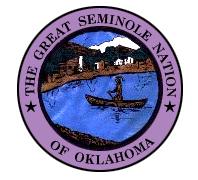The Tusekia Harjo Band is the largest band in the Great
Seminole Nation of Oklahoma.
Tusekia or Tvsekiyv, meaning "one who has
received a war name".
Harjo or Hacho means "a title" like a
Colonel, being courageous, somewhat reckless in war.
The bands that were enrolled during the period of the Dawes
Commission in 1897,
have retained the name sake of the Band Chief of that time
until the present.
Tusekia Harjo Band, are descended from the Okone.
In
the early 1740's and early 1750's an ethnic group, the Okone, moved from the
region of Central Georgia
of the Muskogee towns into the Alachua Prairie region
of north central Florida, the area of the present city of Gainesville.
The Okone behaved as an old Chiefdom regaining their
earlier autonomy.
Their leader, Ahaya or Wakapuchasce (Cow Keeper) had also been
called the founder of the Seminoles,
for although the Okone were not the
earliest of the Prot-Seminole regional chiefdoms, they were the first to be
labeled Seminole.
Some features of the Alachua Okone were clearly recorded.
The Okone had several settlements in the area of the Alachua Prairies,
Cuskowilla being the home of the primary Okone group appears to have belonged to
the Red Division as well as to the Santa Fe Tolofaunder the Okone leadership of
Viokafki or Long Warrior. Alachua Okone Seminoles changed leadership between
1775 and 1785. Payne replaced Cowkeeper as Chief of Alachua.
After Paynes death
in 1812, his brother Hotti Hopoya (Bowlegs) succeeded him as Paramount
Chief of the Alachuas.
Mikkonapa succeeded Bowlegs from 1821 to 1849, Mikkonapa
and five other sub-chiefs,
during a truce conference, were made prisoners of war
on December 14, 1837, while encamped near Fort Mellon.
They were then sent on a
steamer to St. Augustine, and later they were taken to Sullivan Island.
Micanapy Emathla and 218 of their people
were sent by steamer to New Orleans on February 22, 1838 and imprisoned them at the
barracks of Fort Pike.
Huithli Emathla (Jumper) died at the barracks April 18,
1838. The captors collected prisoners at the barracks until mid-May,
when they
sent 1,127 toward Fort Gibson, 47 of them had died by the time they reached Vicksburg. Mikkonapas party reached Fort Gibson in June of 1838.
After moving
to their new land in 1845, Mikkonapa was paramount chief, and died in December
of 1848.
He was succeeded to office by Jim Jumper, his sister's son Mikko Mucasa
(Jim Jumper) from 1851 to 1878.
Cotchaile 1879-? and Tusikayo Hacho in 1898.
Tusikayo Hacho Band fought for the south during the
Civil War. After the war they were removed to what is now Seminole County.
Tusekia Harjo Band at present includes over 2,500
members, the largest of the Seminole Nation Bands under the leadership of Tom
Palmer. They continue to strive for excellence and the right to determine their
place in this world as a sovereign.


![]()